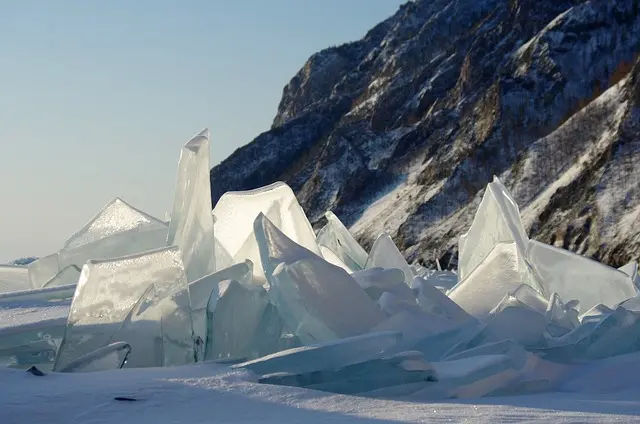
The Colors of Lake Baikal Through the Seasons
Lake Baikal isn’t just a canvas of blue and white—each season brings a vibrant array of colors.
• Winter (1st to 5th month): The lake freezes, with ice up to 70-115 cm thick. Despite Siberia’s chilling reputation, the winter here isn’t as extreme as the Arctic Circle.
• Summer: The peak season is August. Glaciers melt, feeding the lake, and everything basks in the warmth of a cool and lazy summer.
• Autumn: The lake transforms into a painting, with red leaves covering the mountains, steam from small trains winding through the foliage, and sunsets painting the sky.
Sacred Sites of Shamanism around Lake Baikal
Lake Baikal is also considered a holy site for Siberian shamanism. Shamanism isn’t just a part of Chinese historical dramas or northeastern rituals—it’s still practiced in the West as well. Many followers of shamanism come to Baikal for a pilgrimage to connect with the lake’s spiritual legends. Lake Baikal has always been a symbol of uniqueness, richness, and mystery throughout its history.
Shaman Rock
Located in the northern part of Olkhon Island near Khuzhir, Shaman Rock is a significant spot for Shamanists. According to legend, a person with sins would spend a night by Shaman Rock, and if they weren’t swallowed by the lake’s waves, their sins would be forgiven. The rock protrudes slightly above the lake’s surface, but beneath, it stretches into an entire ridge. The rock’s formation may date back to the geological changes in the Angara River, and local legends speak of its power and significance. In winter, you can photograph stunning ice pillars and enormous ice caves around this sacred site.
Lake Baikal’s Unique Features
• Blue Ice: Baikal’s ice includes both blue ice and air bubbles. This phenomenon occurs as the ice forms in layers. It takes a few months to solidify fully, and when it finally does, the ice can reach over a meter thick. The bubbles come from methane gas released by plants at the lake’s bottom, while cracks in the ice are caused by temperature-induced water compression and expansion.
• Baikal Seal: Baikal is home to over 1,700 species, two-thirds of which are unique to the lake. The Baikal seal, the only freshwater seal in the world and the smallest seal species, inhabits the entire lake. This rare species attracts many tourists.
